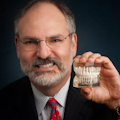Why it’s not just patients who need to say “yes” to treatment
Another important piece of the puzzle in Practice Building 101 is getting to yes. What does that mean? This concept came to me in a very odd way. The concept of yes has always been a big part of my practice-management philosophy. At a dental meeting, I had just finished my lecture and an older dentist was waiting to speak to me. He was wearing a pin that read “YES.” I always wear a giraffe pin. I asked the owner of the YES pin how he got it.
Further reading:
- Part 1 of this series—The first building block for success: Your mission statement
- Part 2 of this series—Why service will lead you to success
“Oh, I saw a guy wearing it,” he replied, “and I asked him where he got it. He just gave it to me. I wear it all the time!”
My next question was, “Can I have your YES pin?”
His response was quick and sure. “After hearing your lecture, I know why you want it, because you spoke about getting yes all the time. And no, you cannot have mine.” He then asked me for my popular giraffe pin, and I easily said no to him.
We both had a good laugh. I then gave him his own giraffe pin. Being willing to “stick your neck out” will get you a giraffe pin.
What does "yes" really mean?
So, what about the concept of yes? It is so easy to say no to everything. “Dr. Hoos, can you cut off my arm and sew it to the top of my head?” Of course the answer can be yes. I use this crazy example as something far-fetched, but it’s a close analogy to what dentists hear frequently in their careers: “Doctor, can you remove all my teeth and give me dentures?”
So if the answer is yes in our practice, we always need to add an additional key phrase, such as: “Let’s talk about the results of doing the treatment you are asking me to do for you.” What does it mean to have all your teeth removed and what will happen if you do? What does getting to yes really mean?
I want to clarify that I am not talking about unethical treatment, overtreatment, acquiescing to crazy dental requests, or compromising your personal dental beliefs and treatments. What I want to do is dialogue with my patients so I can truly understand what they desire for their dental future. I want to impart dental information to my patients, but I cannot have a conversation with someone if the first word out of my mouth is no. That response prevents any chance of creating a lasting relationship with someone.
Think about the yes concept in your personal life. Every action has a consequence, and some of the consequences can be very unpleasant. So, even though you may have said yes to help empower your patient, that person must understand the results of a chosen behavior. The yes concept empowers your client and reduces the negative barriers people naturally set up when they are confronted with the negativity of no.
I heard “no” all the time growing up. “Jeffrey, no, do not do that.” “Jeffrey, no, you cannot have that.” I heard it so often that I thought my middle name was “No”: Jeffrey No Hoos. Negativity holds everyone back and keeps them from achieving their goals.
The other important part of yes when it comes to providing health care is the concept of “informed consent.” Informed consent is about giving the patient enough information so that he or she can make a reasonable decision within the limitation of a layperson’s understanding.
The BRAN theory
We use a formula that I call the “BRAN theory.” BRAN stands for “Benefits, Risks, Alternative treatment, and No treatment.” Benefit statements are the reasons why people buy products or services or agree to anything. When a statement has the word “you” in it, that is a benefit statement. Risks of treatment should be discussed, but that does not mean you have to frighten the patient, and certainly, the more complex the procedure, the more detailed you need to be. All alternative treatments must be discussed. Even if you cannot provide a certain treatment, all alternatives still should be offered. The most important part of the BRAN theory is the “no treatment” option. Not everyone can afford, nor do they desire, the doctor’s concept of how their dental problems should be solved.
Where does this leave us? Try saying yes to your patients first, so you can create a dialogue to help you understand their concerns and desires. You will be amazed at the information you will glean and how it will translate into more dentistry being performed in your office. But, remember, you must always gain informed consent by using the BRAN theory before proceeding with treatment.
Have a great productive month trying to find that balance and learning to say yes. Remember, you need your mission statement along with a commitment to serve your patients. You cannot give the treatment your patients need and deserve without yes. Balancing art, science, and business will lead you the right way.
Editor's note: This article appeared in the March 2022 print edition of Dental Economics magazine. Dentists in North America are eligible for a complimentary print subscription. Sign up here.
About the Author
Jeffrey C. Hoos, DMD
Jeffrey C. Hoos, DMD, a 1978 graduate of the Tufts University School of Dental Medicine, started his private practice as a one-operatory walk-up and grew it to a four-doctor practice with 25 staff members. He lectures on innovative techniques that balance the art, science, and business of dentistry. He is one of the first general dentists to be Brånemark certified for implant placement, and his office has become a teaching center for restorative and implant dentistry. Contact him at [email protected].

